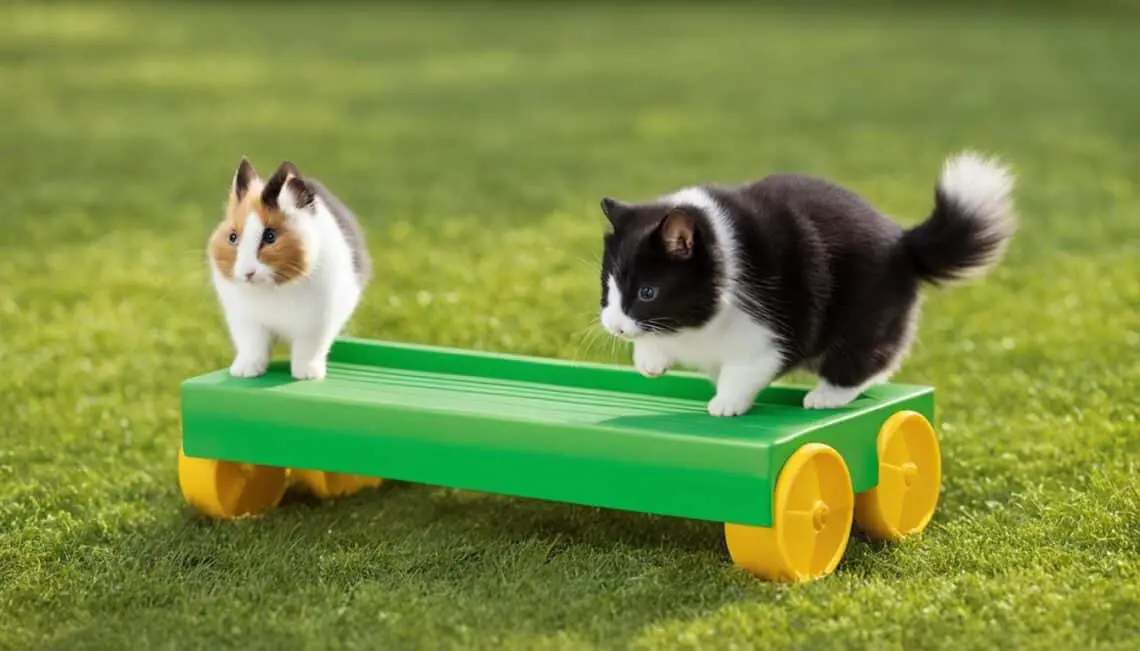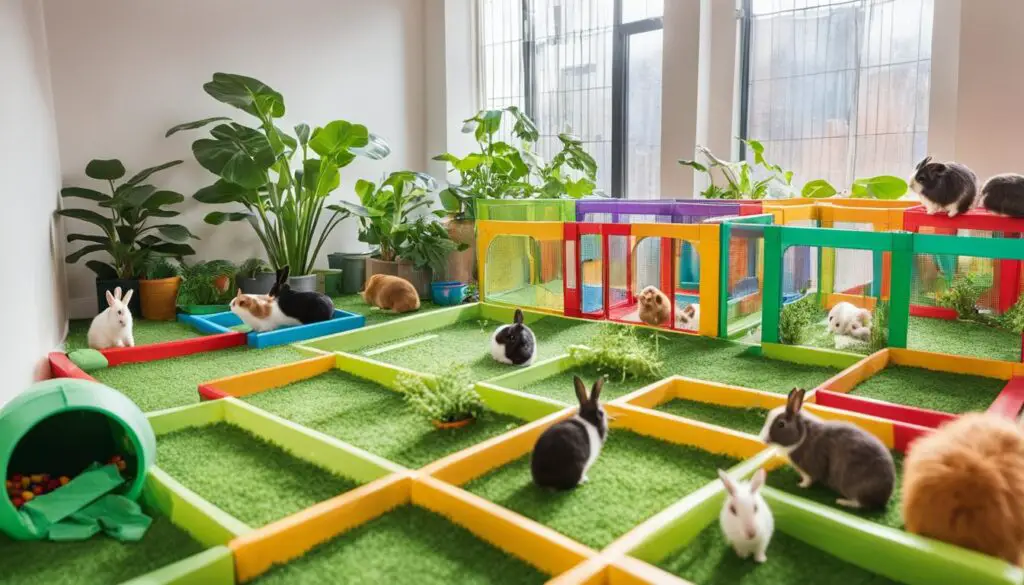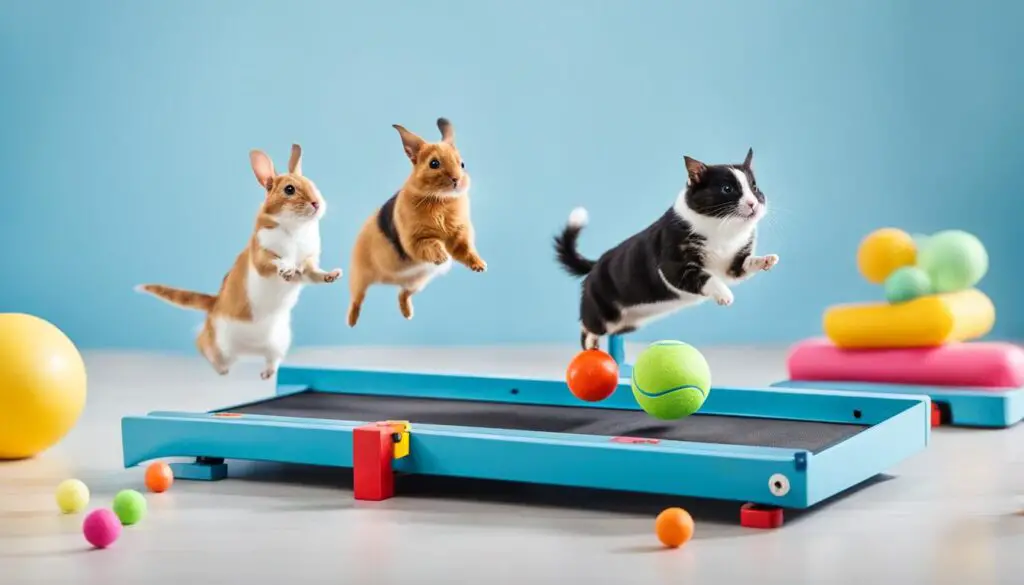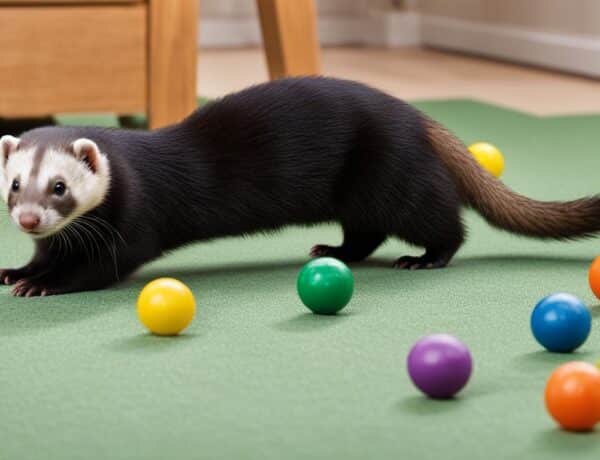Giving regular exercise to our energetic small pets is essential for their overall health and well-being. However, it’s important to understand that different pets need different amounts and types of exercise. Before starting an exercise program for your pet, it’s always a good idea to consult with a veterinarian to ensure you’re providing the right routine.
When it comes to exercise routines for small pets, it’s crucial to start slowly and gradually increase the duration and intensity of the activities. Keep in mind that certain breeds, especially brachycephalic breeds, may have difficulty breathing during exercise, so it’s important to be observant and adjust accordingly.
For indoor cats, there are several ways to encourage them to be more active. Using harnesses, food-dispensing toys, and interactive games can help stimulate their natural instincts and keep them moving. Additionally, physical rehabilitation services are available for dogs with exercise limitations, such as joint problems or heart disease, to improve their strength and mobility.
Exercise Tips for High-Energy Dogs
High-energy dogs like German Shepherds, Malinois, and Retrievers require plenty of exercise to burn off their excess energy. Regular exercise routines not only help these dogs stay physically fit but also provide them with mental stimulation, which is equally important for their overall well-being.
Here are some exercise tips and activities that can help tire out your high-energy dog:
- Playing frisbee: Engaging in a game of frisbee can be an excellent way to challenge your dog’s agility and endurance. Throw the frisbee and encourage your dog to retrieve it, keeping them on the move and providing a high-energy workout.
- Dog parkour: Dog parkour, also known as “urban agility,” involves navigating through various obstacles like ramps, balance beams, and platforms. This activity not only provides physical exercise but also stimulates your dog’s problem-solving skills.
- Learning new tricks: Teaching your high-energy dog new tricks can be mentally stimulating and physically tiring. It engages their focus and concentration while also reinforcing their bond with you.
- Riding a bike: If you have a relatively large outdoor space or a safe biking path nearby, you can consider taking your dog for a bike ride. Attach a specialized bike leash to ensure their safety while giving them an opportunity to run alongside you and burn off excess energy.
- Obedience training: Obedience training sessions not only improve your dog’s behavior but also provide both mental and physical stimulation. Teaching them commands, tricks, and impulse control exercises can help channel their energy in a productive way.
- Group classes: Consider enrolling your high-energy dog in group classes or training sessions. These classes not only provide professional guidance but also offer socialization opportunities, allowing your dog to interact with other dogs and learn how to behave in a group setting.
- Dog backpack and hiking: Incorporating a dog backpack into your exercise routine can add an extra challenge for high-energy dogs. Load the backpack with some weight (appropriately distributed) and take them for a hike. The added weight will make the exercise more intense, further exhausting your energetic dog.
Remember, every dog is unique, and it’s essential to tailor the exercise routine to your dog’s specific needs and abilities. Start slowly and gradually increase the intensity and duration of the activities. Always monitor your dog for any signs of discomfort or fatigue. Providing your high-energy dog with regular exercise will not only keep them physically stimulated but also prevent boredom and potential behavior issues.
When it comes to exercise, high-energy dogs thrive on activities that challenge both their body and mind. Incorporating a variety of exercises and engaging in interactive playtime will not only help burn off their excess energy but also ensure a happy and healthy lifestyle.
Indoor Exercise Ideas for Cold and Wet Days
To keep dogs active and entertained during cold and wet days, there are several indoor exercise options. A game of “keep away” with a soft toy or ball can keep dogs on the move. Running up and down the stairs can provide a good cardio workout, and playing fetch in a long hallway or large room can help burn energy. A rousing game of chase or hide and seek can be both mentally and physically stimulating. Setting up an obstacle course with household items and using food puzzles can provide mental stimulation. Taking the time at home to teach new tricks through positive, reward-based training is also a great indoor activity for dogs.
Importance of Exercise for Small Pets
Exercise is crucial for the well-being of small pets, such as cats and small dogs. Regular physical activity not only promotes good physical health but also plays a vital role in maintaining their mental well-being.
- Preventing Obesity: Engaging in regular exercise helps small pets maintain a healthy weight, reducing the risk of obesity. Obesity can lead to various health issues, including joint problems, diabetes, and cardiovascular diseases.
- Improving Cardiovascular Health: Exercise benefits small pets by improving their cardiovascular health. Just like humans, small pets need regular aerobic exercise to keep their hearts strong and healthy.
- Strengthening Muscles and Bones: Physical activity helps develop and strengthen the muscles and bones of small pets, improving their overall strength and mobility.
- Providing Mental Stimulation: Exercise not only benefits the body but the mind as well. Engaging in physical activities provides mental stimulation, which helps prevent behavioral problems in small pets.
It is important to note that exercise routines should be tailored to the specific needs and abilities of each small pet. Starting slow and gradually increasing the intensity and duration of the activities is essential to avoid strain or injuries.
Be mindful of any signs of discomfort or pain during or after exercise. If your small pet shows any signs of distress, consult with a veterinarian to ensure their safety and well-being.
By incorporating regular exercise into the daily routine of small pets, you can help them lead a healthy and fulfilling life.
Exercise Guidelines for Small Pets
- Consult with a veterinarian to determine the appropriate exercise routine for your small pet.
- Start with low-impact activities, such as short walks, gentle play sessions, or interactive toys.
- Gradually increase the duration and intensity of the activities as your small pet builds strength and endurance.
- Provide mental stimulation through puzzle toys, interactive games, and training sessions.
- Consider indoor exercise options for days when outdoor activities are not feasible.
- Always monitor your small pet during exercise and adjust the intensity or duration accordingly.
Remember, maintaining an exercise routine tailored to your small pet’s needs is key to ensuring their long-term health and happiness.
Conclusion
Exercise plays a vital role in the overall health and well-being of small pets. It is essential to consult with a veterinarian to determine the most suitable exercise routine for your pet, taking into account their individual needs and abilities. By providing regular physical and mental stimulation, you can contribute to keeping your small pet happy, healthy, and mentally sharp.
When starting an exercise program for your small pet, it is important to begin slowly and gradually increase the intensity and duration of the activities. This approach helps prevent any discomfort or pain and allows your pet to build endurance over time. Always monitor your pet for any signs of distress or injury during and after exercise to ensure their safety.
Implementing proper exercise routines and activities will help ensure that your energetic small pet leads a fulfilling and active lifestyle. Along with the obvious physical benefits, regular exercise helps prevent obesity, improves cardiovascular health, and strengthens their muscles and bones. Additionally, exercise provides mental stimulation, which is crucial in preventing behavioral problems in small pets.
So, whether it’s a game of indoor fetch, a brisk walk around the block, or engaging in interactive playtime, make exercise a priority in your small pet’s life. It is a simple yet powerful way to enhance their overall health and quality of life.
FAQ
What types of exercise routines should I provide for my energetic small pet?
Different pets need different amounts and types of exercise. It is important to consult with a veterinarian to determine the appropriate exercise routine based on your pet’s individual needs and abilities.
How can I tire out high-energy dogs?
Engaging activities such as playing frisbee, dog parkour, and learning new tricks can help tire out high-energy dogs. Riding a bike and obedience training are also effective ways to provide physical and mental stimulation for these dogs. Group classes can be beneficial as well.
What are some indoor exercise ideas for cold and wet days?
On cold and wet days, you can play “keep away” with a soft toy or ball, run up and down the stairs, play fetch in a long hallway or large room, engage in a game of chase or hide and seek, set up an obstacle course with household items, use food puzzles, or teach new tricks through positive, reward-based training.
Why is exercise important for small pets?
Exercise is important for small pets to maintain good physical and mental health. It helps prevent obesity, improves cardiovascular health, strengthens muscles and bones, and provides mental stimulation to prevent behavioral problems.
How can I determine the appropriate exercise routine for my small pet?
It is important to consult with a veterinarian to determine the appropriate exercise routine for your small pet based on their individual needs and abilities. Start slow, gradually increase the intensity and duration of the activities, and monitor your pet for any signs of discomfort or pain.







No Comments